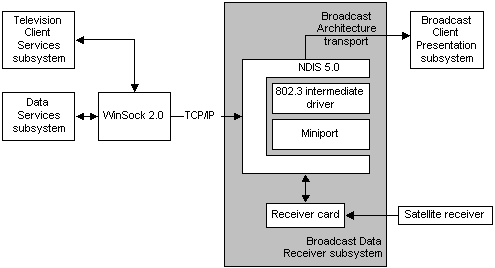
[This is preliminary documentation and subject to change.]
The broadcast client receives a number of different data streams over one or more broadcast networks by means of miniports. Broadcast Architecture NIC miniports, drivers for the Microsoft® Windows® 98 operating system, allow different hardware devices to have a common interface to the broadcast client. These miniports conform to the Network Driver Interface Specification (NDIS) version 5.0 including the Broadcast Architecture NDIS extensions. For more information on Broadcast Architecture NDIS extensions, see the NDIS Extensions section of the Broadcast Architecture Device-Driver Kit (DDK), part of the Windows 98 DDK.
A Broadcast Architecture NIC miniport splits broadcast data into two streams. The first stream includes audio and video data sent by way of the Broadcast Architecture transport to the DirectShow filter graph. Any other data received, such as Hypertext Markup Language (HTML) pages, data files, or control information, is formatted as Internet Protocol (IP) packets and sent to Windows Sockets (WinSock) version 2.0.
Applications that require a back channel to the server can connect to another network by using WinSock. Routing all data through WinSock simplifies the interface to the server, as WinSock then provides a single application programming interface (API) for data exchange.
The following illustration shows how the components of the Broadcast Data Receiver subsystem fit together.

The following topics briefly describe the components of the Broadcast Data Receiver subsystem.
WinSock 2.0, a Windows API, is a Windows 98 system component. It provides a networking standard that gives applications an abstraction of the networking software below it. In Broadcast Architecture, WinSock handles digital computing data, as opposed to audio and video data streams.
Transmission Control Protocol/Internet Protocol (TCP/IP) is the industry-standard protocol used by WinSock 2.0 to send and receive data. WinSock packages and unpackages data into IP packets that it sends to and receives from a TCP/IP network.
The Broadcast Architecture transport is a Broadcast Architecture component. The Broadcast Architecture transport allows various system components to move audio and video data through the system. It is a high-bandwidth transport with special support for features such as television channel selection. For more information, see the Broadcast Architecture Transport section of the Broadcast Architecture DDK.
NDIS 5.0 is a device driver model for Windows 98 and the Microsoft® Windows NT® operating system that provides an operating system-independent standard for writing network device drivers. NDIS 5.0 allows independent hardware vendors (IHVs) to extend existing drivers to create hardware-specific drivers; the extensions written by an IHV are called a miniport. In Broadcast Architecture, NDIS-compliant miniports provide an interface between network interface cards (NICs) and other broadcast client components.
A Broadcast Architecture NIC miniport, provided by an independent hardware vendor, is the NIC-specific portion of an NDIS 5.0 driver. Each type of NIC requires a unique miniport. For more information, see the NIC Miniport section of the Broadcast Architecture DDK.
The NDIS 802.3 intermediate driver is a Broadcast Architecture component that translates Multipacket Transport (MPT) packets, from satellite networks, into IP packets. This translation makes it possible for WinSock to handle satellite data as it does any other data carried by TCP/IP.
A receiver card is a component provided by independent hardware vendors. This card receives incoming broadcast signals and converts them to data the computer can use. In Broadcast Architecture, it provides a point of entry for broadcast data into the system.